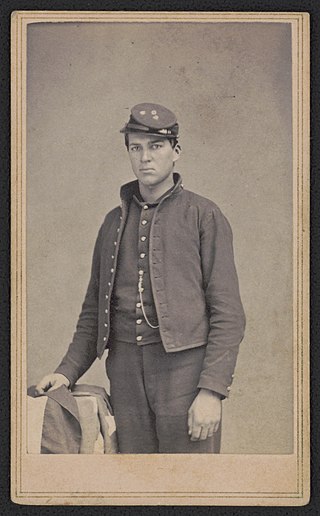Related Research Articles
The Battle of Fort Bisland was fought in the American Civil War between Union Major General Nathaniel P. Banks against Confederate Major General Richard Taylor during Banks' operations against the Bayou Teche region in southern Louisiana.

The 3rd New York Infantry Regiment was an infantry regiment that served in the Union Army during the American Civil War. It is also known as the Albany Regiment.

The 10th New York Infantry Regiment was an infantry regiment that served in the Union Army during the American Civil War. It was also known as the McChesney Zouaves or National Guard Zouaves.

The 121st New York Infantry Regiment, commonly known as the "Onesers" or "Upton's Regulars", was a volunteer regiment recruited during the American Civil War from Otsego County and Herkimer County, New York. The Hon. Richard Franchot was appointed colonel of the regiment and authorized to establish his headquarters at Richfield Springs, Otsego County. He proceeded without delay to organize the regiment, and on August 23, 1862, the regiment was mustered into the service of the Union Army. The command at that time consisted of 39 officers and 946 enlisted men. The 121st Regiment proceeded to Washington, arriving there on the morning of September 3, and was assigned provisionally to a brigade under Colonel Gibson with headquarters at Fort Lincoln.
The 178th New York Infantry Regiment was an Infantry Regiment that served in the United States Army during the American Civil War. It was often referred to as the "Second Regiment, Hawkins Zouaves".

Andrew Cowan served as a Union artillerist in the American Civil War. He distinguished himself at the Battle of Gettysburg and the Battle of Sayler's Creek. Subsequently, he "amassed a fortune in the leather industry and used that wealth in a variety of philanthropic activities. In addition, he was a prominent force in healing the wounds between the North and South and bringing peace to a fractured nation."
Elijah Daniel Taft (1819-1915) was an artillery officer in the Union Army during the American Civil War.
Battery E, 1st Rhode Island Light Artillery Regiment was an artillery battery that served in the Union Army during the American Civil War.

The 118th New York Infantry Regiment was recruited for service in the American Civil War (1861–1865) from Clinton, Essex, and Warren counties in Northern New York. Known as the Adirondack Regiment, the unit saw service along the Atlantic Coast in the Department of Virginia before transferring to the Army of the James in 1864. With the latter, they were engaged in the Overland Campaign and the subsequent siege of Petersburg.

The 67th New York Infantry Regiment was a regiment of the Union Army, which was raised in the city of Brooklyn in 1861 at the beginning of the American Civil War.

The 45th New York Infantry Regiment, also known as the 5th German Rifles, was an infantry regiment that served in the Union Army during the American Civil War. It was composed almost entirely of German immigrants. Formed approximately five months after the start of hostilities, the unit's service spanned almost the entirety of the war, and it saw action in several of the war's noteworthy battles, in both the Eastern and Western Theaters.

The 2nd New York Heavy Artillery Regiment was a heavy artillery regiment that served in the Union Army during the American Civil War. During the Siege of Petersburg the regiment operated as infantry.
The 4th New York Heavy Artillery Regiment, U.S. Volunteers was a heavy artillery regiment that served in the Union Army during the American Civil War. The regiment operated as both heavy artillery and infantry beginning in February 1862 while serving in the defenses of Washington, D.C., and continued in both capacities until the end of the war.
The 11th Independent Battery, New York Volunteer Light Artillery or 11th New York Light Artillery was an artillery battery that served in the Union Army during the American Civil War.

The 95th New York Infantry Regiment was an infantry regiment in the Union Army during the American Civil War.

The 65th New York Infantry Regiment was an infantry regiment in the Union Army during the American Civil War. The regiment wore distinctive chasseur styled uniforms. Its members were recruited primarily from New York, but included recruits from Connecticut, Rhode Island, and Ohio.
The 3rd Independent Battery, New York Volunteer Light Artillery or New York Independent Light Artillery was an artillery battery that served in the Union Army during the American Civil War.

The 1st New York Light Artillery Battalion was a New York State volunteer artillery unit that served in the Union Army during the American Civil War. The unit was initially composed of four artillery companies, which were mustered-in for service in late 1861. Throughout 1862 and early 1863, the battalion saw action in the Eastern Theater before it was reorganized into four independent batteries of the New York Light Artillery, which fought separately for the remainder of the war.

The 2nd New York Cavalry Regiment, officially known as the 2nd Regiment, New York Volunteer Cavalry, was a unit of the Union Army during the American Civil War. It served with the Army of the Potomac and fought in Stoneman's 1863 raid, the Wilson–Kautz Raid, and the Battle of Appomattox Station.

The 15th Independent Battery, Volunteer Light Artillery was an artillery battery that served in the U.S. Army during the American Civil War.
References
- Parsons, Philip W., The Union Sixth Corps in the Chancellorsville Campaign, Jefferson, NC: McFarland, 2006. ISBN 0-7864-2521-0
- Phisterer, Frederick, New York in the War of the Rebellion, 6 vols., Albany, J.B. Lyon company, state printers, 1912.